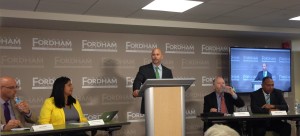Transforming Decades of Failure
Erin Gruwell, the inspirational teacher behind Freedom Writers, continues to be one of the few educators fueling my desire to teach in a low-income area. Her experience as a transformative educator showed me the power of the teacher in a classroom. However, many teachers remain ineffective in the classroom. The Thomas B. Fordham institute hosted a panel discussion in which individuals talked about their experiences with turnaround school districts in Louisiana, Michigan, and Tennessee.
A turnaround school district is one in which previously failing schools are “turned around” into successful schools through various changes in school leadership. Schools are not being closed or recreated as Chris Barbic, the superintendent of the Achievement School District, and Veronica Conforme, the chancellor of Michigan’s Education Achievement Authority, have made evident. Conforme and Barbic made very clear that turnaround efforts are transforming the neighborhoods into areas of success, not recreating the neighborhoods. This is important to note because it shows that the integrity of the neighborhood is not lost under new school leadership, but rather efforts are made to equip students with the resources to enhance the community in which they live. Turnaround efforts enhance the practices and schools in place. This also helps to encourage community involvement without making it seem like external organizations are imposing themselves upon these communities labeled “failing” and “impoverished”.
 It was interesting to see how improving schools can have a transformative effect on the whole community. Patrick Dobard, the superintendent of the Louisiana Recovery School District, notes that these turnaround school districts often are in areas of generational poverty and work tirelessly to allow disadvantaged students to escape the cycle of poverty. Poverty places a great burden upon communities, but equipping them with the resources to overcome this cycle will help empower the young community members to transform their neighborhood and family. Bringing new leadership and a breath of fresh air into these communities allow the schools to produce students that will not only break the cycle of poverty in their community, but hopefully encourage students to take home the practices learned in school to empower other community members.
It was interesting to see how improving schools can have a transformative effect on the whole community. Patrick Dobard, the superintendent of the Louisiana Recovery School District, notes that these turnaround school districts often are in areas of generational poverty and work tirelessly to allow disadvantaged students to escape the cycle of poverty. Poverty places a great burden upon communities, but equipping them with the resources to overcome this cycle will help empower the young community members to transform their neighborhood and family. Bringing new leadership and a breath of fresh air into these communities allow the schools to produce students that will not only break the cycle of poverty in their community, but hopefully encourage students to take home the practices learned in school to empower other community members.
Hearing about efforts to turn the bottom 5% of schools into the top 25% of schools heightened my desire to teach in a low-income area because of the passion these panelists had for the work they are doing. Schools have a powerful effect on the community in which they are located and making schools a place of success in an otherwise impoverished area will have a positive and transformative effect far outside the boundaries of the school.
Elizabeth Kennard, CER Intern















No comments at this time.